SEO Copywriting: The 19 Best Tips To Increase Traffic and Conversions
We can all agree that writing amazing copy is a lot harder than it sounds.
After all, you don’t just have to write words that are persuasive.
You have to get them to rank in search.
And doing both at the same time is a real challenge.
Don’t worry. We got you.
In this guide, we’ll give you 19 super-actionable SEO copywriting tips that you can use right now.
Let’s dive in.
Table of Content
1 What is SEO Copywriting?
2 Writing Copy That Engages Readers
3 Writing Copy That Ranks In Search
4 Write Copy That Crushes It In Search
What is SEO Copywriting?
When you do SEO copywriting, you have two jobs.

On the one hand, you’re a copywriter. Copywriting is persuasive writing that gets people to say yes. You’re using principles from psychology and behavioral science to get people to take action.
On the other hand, you’re an SEO specialist. SEO writing is writing that’s optimized to rank in search. You’re using your understanding of the Google algorithm to help your copy rank for your target keywords.
Suppose you’ve carefully chosen your target keywords, optimized your title tags and meta descriptions — but never bothered to create effective copy.
Most visitors will bounce as soon as they land on the page. And your page will never manage to rank highly.
If you go all in on writing awesome copy but don’t take the time to optimize for SEO, you’re also sunk.
Your page will rank so far down in Google’s search results that you’ll never pull in a steady stream of visitors.
SEO and copywriting go hand in hand.
To build a successful site, you need both.
Let’s take a closer look.
Writing Copy That Engages Readers
Engaging readers and ranking in search can be tricky. Fortunately, Google is optimized more than ever before to deliver results that meet reader needs.
And that makes it a lot easier to craft compelling copy that performs great in search.
Put your reader first — then optimize for search. Focus on the reader and you won’t go wrong.
1. Analyze Competitor Blog Posts
Your content will be going up against every other relevant piece of content out there.
And when you consider how much competition is out there, that’s pretty daunting.
In August 2020, over 71 million new blog posts were published — and that was just on WordPress.

The key to standing out? Make your content as comprehensive and relevant as possible.
That’s the idea behind Brian Dean’s skyscraper technique.
When you cover everything that searchers expect to know, you’re not just serving them. You’re also showing Google that you’ve created an awesome page that deserves a top spot in the search results.
And if you want to make that happen, you need to start by looking at what’s already out there.
Looking at existing articles on your topic is a great way to know what should go in your article.
Suppose you want to write an article on how to be more productive.
From a quick look at the top articles that come up in search, you can easily see the topics that come up again and again — so you’ll definitely want to cover those, too.

It’s a simple way to make sure you cover the topics your readers want to know about.
2. Explore Online Courses
Online courses are another terrific guide for structuring your content.
Typically, they’ve been developed by authorities in their field. And the best have often been watched thousands of times — so you know they’re a great guide to what readers are looking for.
Imagine you’re planning a series of articles on personal productivity.
Head over to online course sites like Skillshare or Coursera and search for “productivity”:
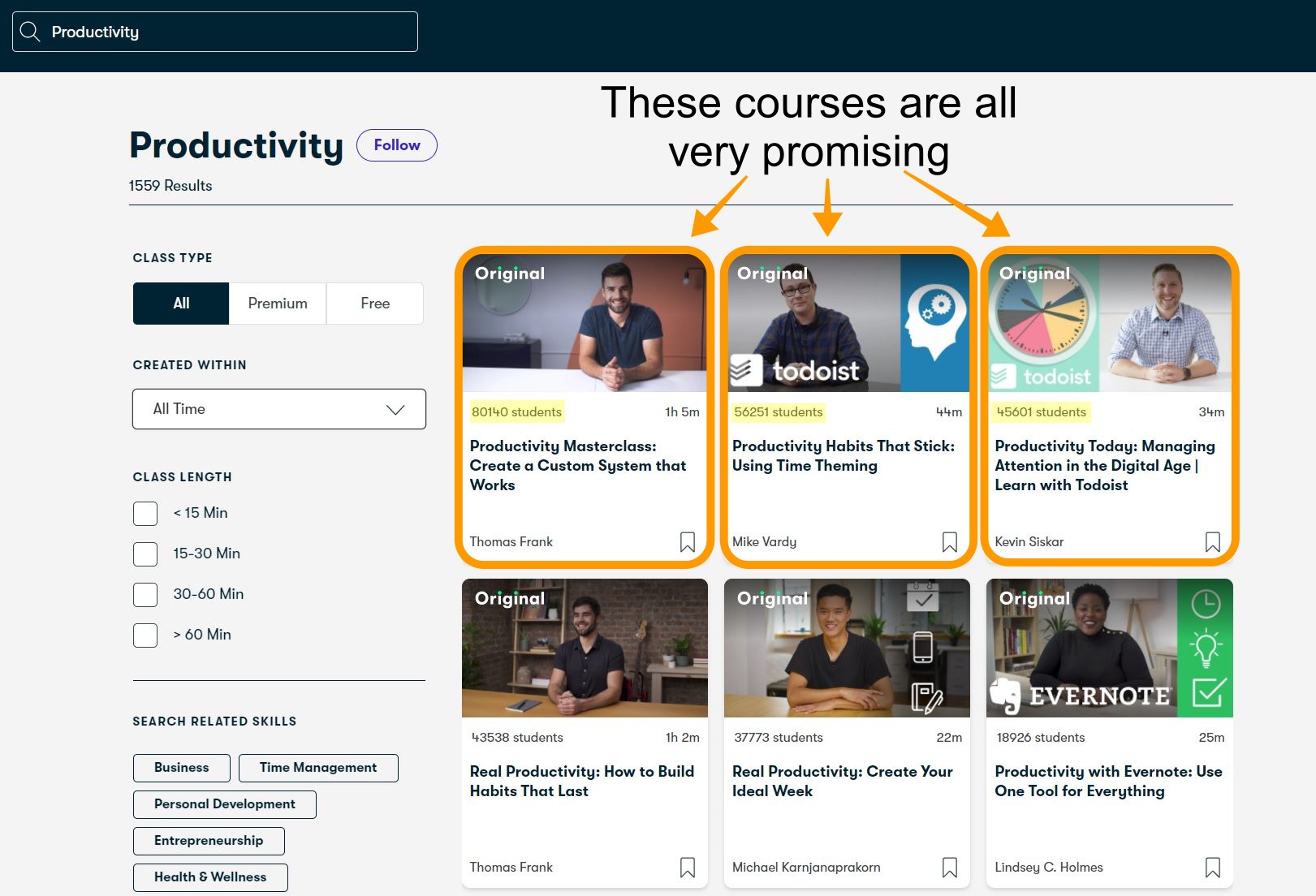
Start looking through some of the most popular courses.
Take a look at the content section…
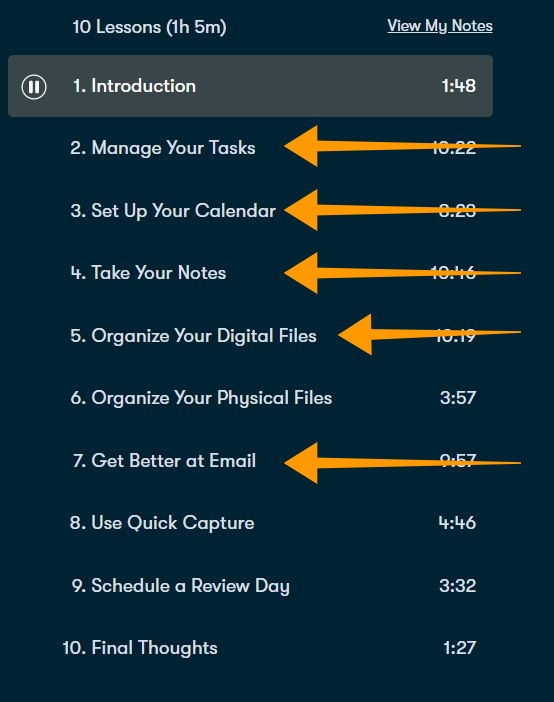
…and you’ll find lots of reader-friendly topics to include in your own content.
3. Answer Reader Questions
It’s not exactly news that we use Google more than ever to answer our own questions.
Around 8% of online searches are question-based. And the rise of Google Assistant is just accelerating that trend.
It just makes sense to create content that answers readers’ questions.
But how do you know what they’ll be asking?
Enter AlsoAsked.com.
It’s a free tool that lets you see all the relevant questions from Google’s “People Also Asked…” section — for any search term.
Let’s say you’re still developing that series on productivity — and you want to know what questions people might have.
Just enter your primary keyword into AlsoAsked:

Hit search, and you get tons of great questions. Many of these you may not even have thought of, like “How can I make 2020 my year?”

Clicking on any question generates even more questions that people also asked:
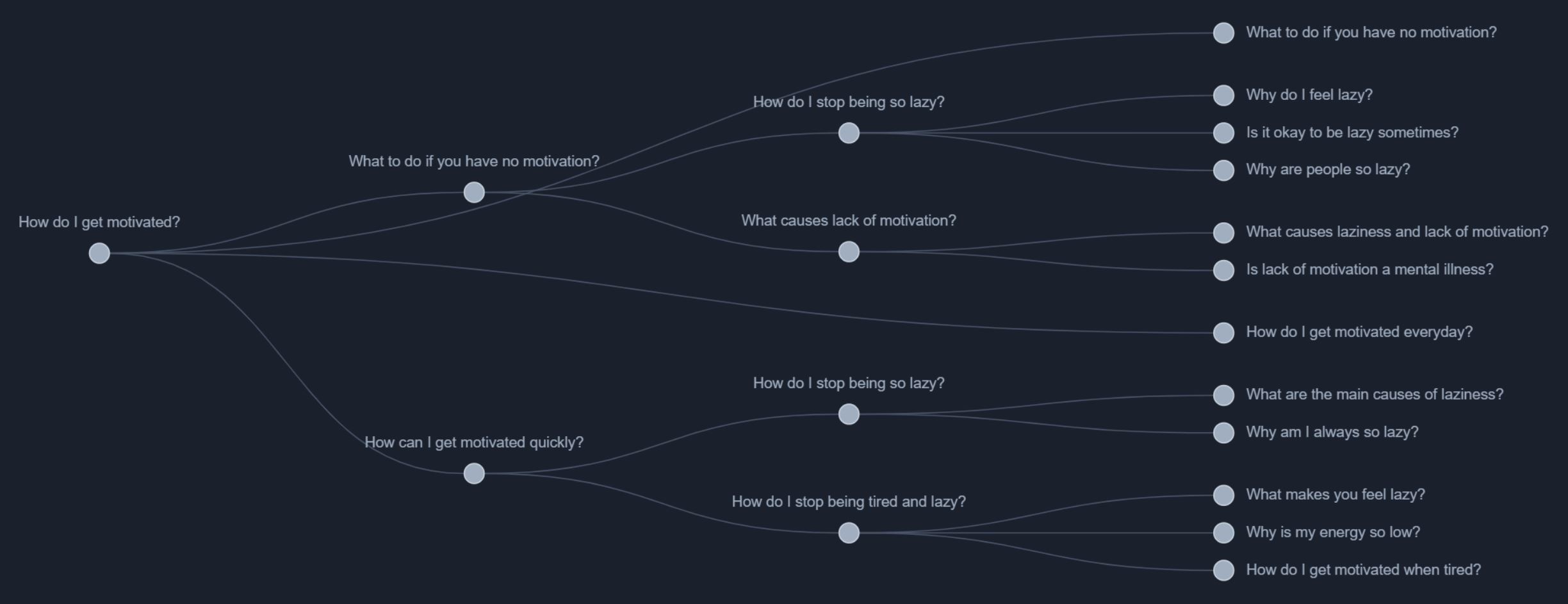
Knowing the exact questions readers are asking is like being a mind reader.
When you can build those questions into your content, you’re responding to the exact challenges and pain points your readers want help with.
And when you do that, you aren’t just creating a more valuable resource.
You’re also helping your page rank for lots of long tail keywords.
And as your page attracts more visitors, Google will take notice — and give you a prime spot on its SERPs.
4. Create a Slippery Slide
It’s simple.
You want your copy to be irresistible.
And that means it should be a slippery slide.
Start with your headline.
It should be so compelling and irresistible, that it pulls readers into the subheading.
Next look at the subheading.
Your subheading should be so compelling that it pulls readers into the first sentence of your body copy.
The job of your first sentence? You guessed it: to intrigue readers and keep them reading the second sentence — and so on, all the way down to the bottom of your page.
Check out how Ramit Sethi builds a slippery slide:

Every sentence on the sales page for his Earnable program is directly focused on the reader.
You’re naturally pulled along into his body copy, which continues to build curiosity and gets you wanting to learn more.
It’s a masterful example of a slippery slide in action.
And it starts with a great headline.
5. Use Headlines to Seize Attention
Looking for a quick win?
Your headline is the place to start.
The fact is that simply writing a better headline can have an enormous impact.
SEO guru Brian Dean took one of his top-performing articles, and tested a new headline designed to generate curiosity:

The result: a 45% lift in organic traffic.

Your headline captures reader attention and provokes curiosity.
And once they’ve read it, your readers should be so intrigued that they can’t wait to find out what’s next.
Here’s how to make sure your headline is getting the job done.
Use Proven Formulas: As Elise Dopson points out, battle-tested headline formulas have gotten solid results again and again and again. If you’re not sure what to do, using one of these proven formulas is a great place to start:
- Why does / doesn’t [something] do [something]?
- [Number] [Power Word] Facts About [Topic]
- How to [Do Task] (Without [Thing])
- The Shocking Reason Why [Pain Point]
- [Keyword]: Everything You Need to Know
- How to [Keyword] in [Number] Simple Steps
Be specific: Vagueness repels readers. After all, people usually don’t click on something if they don’t know what they’re getting into. That’s why headlines that convey a specific message work best in search.
And the simplest way to do that? Use numbers.
As Buffer’s Courtney Seiter says, “numbers work well in headlines because humans like predictability and dislike uncertainty.”
To really make this strategy work for you, use highly specific numbers.
Like this:

In research for BuzzFeed, data scientist Gilad Lotan found that listicle titles with seemingly random numbers, especially odd numbers, generated more clicks than those containing round numbers like 5 or 10.

6. Use Curiosity to Get Clicks
Now, I’m not a huge BuzzFeed fan.
But I’ll admit I’ve read articles on there every now and again. And it’s their clickbaity headlines that pull me in every time.
Sometimes they’re ridiculous.


But you can make them work for you.
Brad Smith suggests trying these clickbait style headlines to infuse more curiosity into your writing — and they’re totally on point.
- [People / Company] [Did Something Incredibly Difficult] And It [Didn’t End Like You Think It Would]
- [Number] Things Nobody Tells You About [Difficult / Complex Topic]
- [Overhyped Thing] vs [That Same Thing] In Real Life
- [Number] [Power Word] Tips Guaranteed to Make You [Accomplish Difficult Task] Like a Pro
- Here’s Exactly How To [Accomplish Difficult Task] This Week
When you experiment with headlines like these, keep your audience and your brand in mind. Go overboard, and you could damage your reputation.
Give it a try! You might be surprised at the results.
7. Write a Simple, Spellbinding Intro with the APP Method
Once you’ve got people into your article, the next step is to craft an introduction that keeps them reading.
And the best way to write a compelling introduction?
Keep it super simple.
By doing that, you create a smooth experience that naturally keeps the reader moving into your content.
And Brian Dean’s APP Method is the perfect way to do it.
APP stands for Agree, Promise, Preview.
First, agree. Make a statement you know the reader will agree with.
Make sure it’s relevant to the topic of your article. This gets the reader nodding along with you right from the start.
Next, promise. Talk about how you’ve used these exact tactics to get amazing results — and your reader can do the same.
Finally, preview. Offer a short one sentence summary that lets your reader know what to expect from your article.
Jacob McMillen does a masterful job using these steps to grab reader attention in his article on doubling your freelancing income:
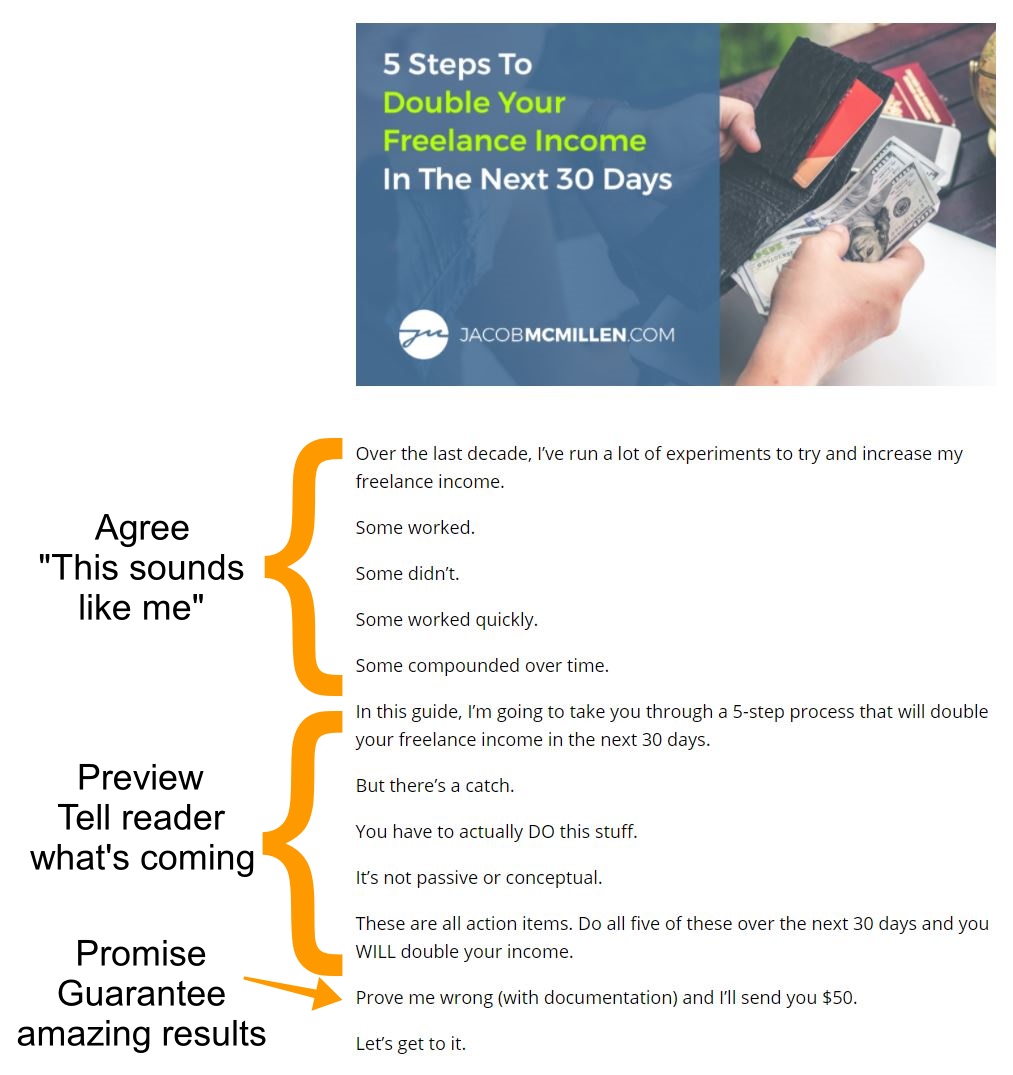
Let’s keep moving.
8. Front Load Information with an Inverted Pyramid
There’s a reason the APP method is so effective.
It cuts to the chase right away.
But most pages don’t do that.
They load you down with multiple introductory paragraphs before you get to the good stuff.
Superstar conversion copywriter Joanna Wiebe calls this warm-up copy.
It’s an easy way to kill conversions. And it’s easy to avoid.
Just build an inverted pyramid.
With the inverted pyramid method, you give your reader what’s most important first, without making them wait.

It’s a strategy journalists have been using for years. And there’s no better way to get readers the information they need, fast.
Pioneer Woman Ree Drummond gets it:
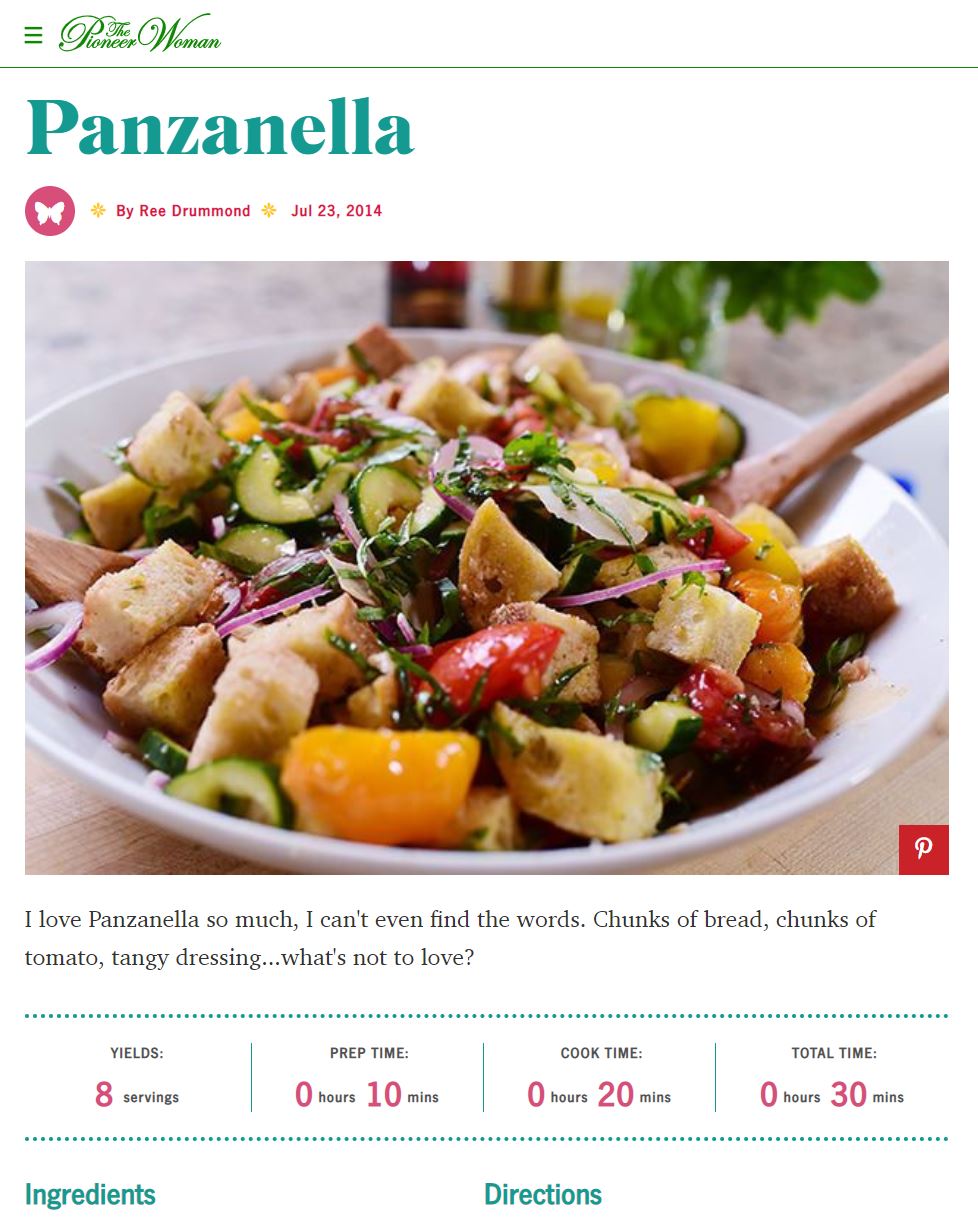
Check out how she only gives 22 words of introduction before dishing out her recipe for panzanella.
Compare that to Deb Perelman in the Smitten Kitchen…
…where you’ll have to work through 471 words of text before getting to her recipe for Shaved Fennel and Crushed Olive Salad.
You know why readers are coming to your page. And the faster you give it to them, the more they’ll love you.
9. Include a Table of Contents
Your days are packed full.
And your readers’ are, too.
They don’t have time for lazy content that doesn’t deliver the goods.
As soon as they land on your page, your visitors are asking themselves, “Will I get anything good out of this? Is it worth my time?”
And as soon as they decide the answer is no, they’re gone.
So how can you convince them to stick around?
Create a table of contents.
Check out how Ryan Robinson did this. In his 5,279-word guide to keyword research, he doesn’t leave readers wondering if they’ll get value out of it.
Right up front, he offers a table of contents that shows exactly what’s covered:
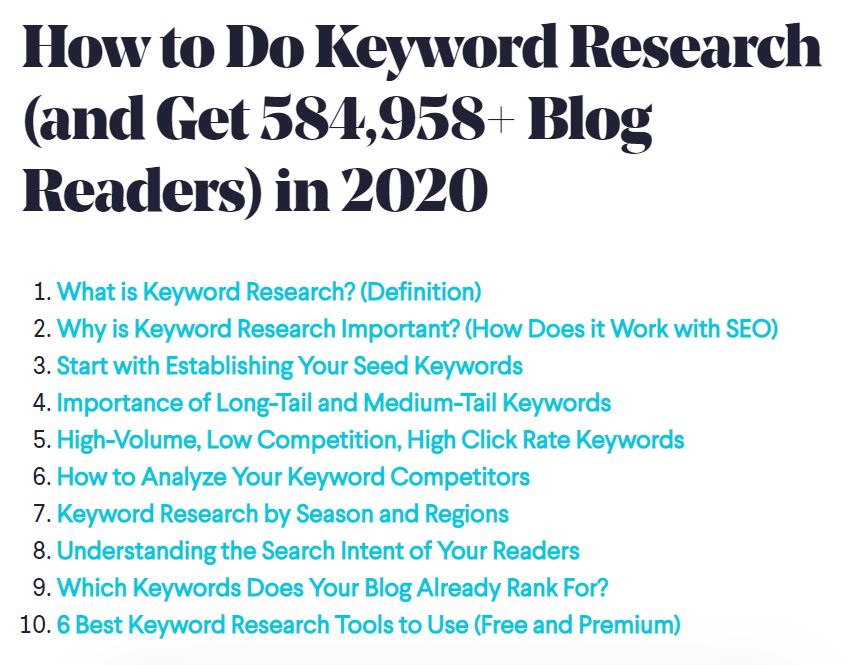
This technique immediately shows readers what they can expect — so they can decide whether the content is worth their time.
Tables of contents also quickly help readers sift through content to find what they’re looking for.
For example, visitors to Ryan’s article who want guidance on keyword research tools can easily find what they’re looking for right from the table of contents.

It’s an easy way to quickly show that your page is relevant to the right readers.
10. Plant Seeds of Curiosity
Here’s the deal.
If you really want to keep readers moving down your slide, you’ve got to prime them to keep reading.
How?
With a proven copywriting technique called seeds of curiosity.
Seeds of curiosity are super-short sentences that you scatter throughout your copy any place you think readers’ interest might start to wane.
And if you’ll notice, I used one right at the start of this section.
Examples are sentences like these.
- But there’s more.
- So read on.
- Let’s dive in.
- But I didn’t stop there.
- Let’s take a closer look.
- Let me explain.
- So read on.
- But there’s more.
- Now here comes the good part.
Copywriter Joe Sugarman talks about how effective this technique can be in his classic Advertising Secrets of the Written Word:
These seeds of curiosity cause you to subconsciously continue reading even though you might be at a point where the copy slows down… Using these seeds of curiosity enhances most copy. But like every good thing, don’t overdo it.
Using this technique in your copy couldn’t be simpler.
Start by reading through your content.
Anytime you notice a place where you feel like someone might click away from your page, plant a seed of curiosity.
There’s no easier way to raise engagement and increase reader time on page.
11. Build Anticipation with Open Loops
If you’re like me, you’ve probably binged your fair share of shows during the pandemic.
Game of Thrones. Billions. This is Us.
(Okay, maybe not that last one.)
And it’s nice to think you’re in control of your viewing choices, right?
Not so fast.
Most television series include multiple cliffhanger moments that leave you on the edge of your seat, wanting to know what’s going to happen next.
Like at the end of Sherlock Season Two, when the show killed off its main character.

Wait, what? How?
I know.
And the show left viewers wondering for two years what had happened. (Watch the show to find out.)
Writers call these moments open loops.
And you can build them into your writing too.
Open loops trade on a psychological phenomenon called the Zeigarnik Effect.
The Zeigarnik effect says that we crave closure. And our minds are drawn back to unresolved situations, again and again, until we get resolution.
Check out how Jeff Kahn sets up an open loop right in the headline in this article for Close:
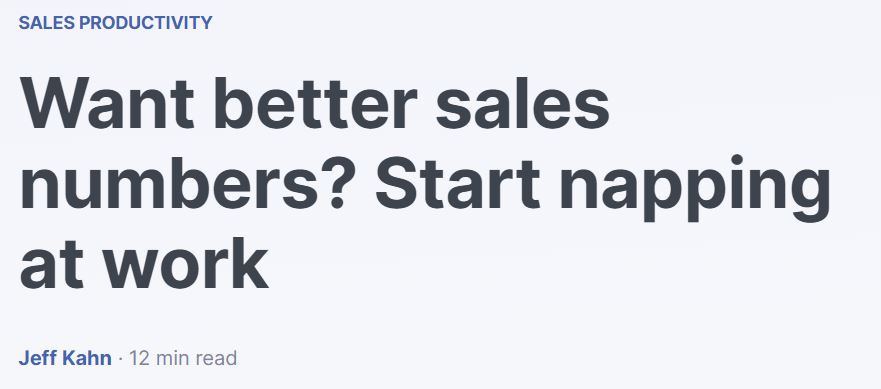
“Napping at work? How? I want to do that.”
Headlines like these elicit curiosity right away. They’re a super-effective way to pull readers into your body copy.
You can also set up open loops in your body copy, like Joel Klettke does at the start of his guide to case studies for Copyhackers:
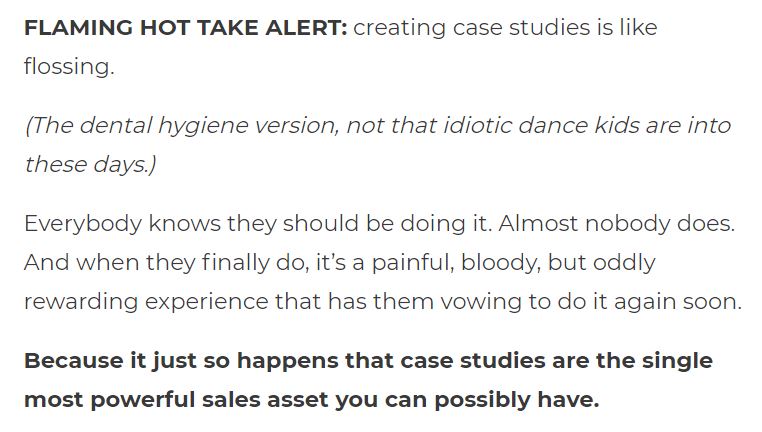
If you want to get your readers so hooked on your content that they forget to tune in for Succession, open loops are the way to go.
12. Use Easy-to-Read Formatting
You know it’s true.
When you go online, you aren’t reading. You’re scanning.
You want to get the information you need as quickly as possible. And so do your readers.
And if you create a simple, reader-friendly experience, your visitors will love you for it.
Here’s how.
- Headings and bulleted lists: Using frequent headings and bulleted lists make for an easy reader experience. But they also make the writing process easier. Sketch out your key ideas first in your headings, and you can fill in the main text later. It’s an easy way to superpower your writing process.
- Pull quotes: Quotations can make a great visual element to break up your text. Don’t be intimidated. You don’t necessarily need to interview an expert or create a custom visual image to do this effectively. Sourcing quotes from existing content can work perfectly well here.
- Include visuals: Content that lacks visuals tends to have a wall-of-text feel that repels visitors. Including visuals doesn’t just break up your text. It gives your content a more professional look, garnering more shares and boosting readership.
In one study, BuzzSumo found that adding visuals approximately every 75 to 100 words is optimal for maximizing social shares.
And it goes without saying: all your images should have alt-text to make sure your content performs well in search.
13. Write Copy That Sounds Like Your Readers
Your target audience is unique.
If you’re trying to reach coffee aficionados, you can bet they won’t speak the same language as college basketball fans or stay-at-home moms.
Your audience speaks their own language. And if you want to connect with them, you’ve got to tune into it.
How? With voice-of-customer data.
Voice-of-customer data gives you insight into the exact words and phrases your target audience is using.
It gives you insight into the questions they’re asking.
And it helps you understand the challenges and pain points they’re dealing with.
All that information is a gold mine when you want to write copy that gets your audience to say yes.
Gathering voice of customer data doesn’t have to be hard.
Just go hang out where your audience is hanging out. And listen.
Here are a couple of great places to start gathering voice of customer data:
Explore Reddit Conversations
Reddit is one of the biggest online communities today, with forums on virtually every topic imaginable. Just search for your topic, and you’ll quickly find relevant subreddits. For example, if you explore the productivity subreddit, you’ll quickly find great conversations like these:

And if you dig into those comments, you’ll find lots of threads that give you great insight into content you could create for your target audience.
Analyze Amazon Reviews
Amazon is more than a place to buy books — it’s a thriving community with thousands of members leaving reviews on virtually every topic. Reading through those reviews is a great way to learn more about your target customers.
Head over to Amazon and search for your topic:

Browse through the results. Focus on titles with lots of reviews.
You’ll find that these reviews often give you a surprising amount of insight into your audience:

With reviews like these, you can quickly get up to speed on the exact words and phrases your audience is using.
It’s an awesome way to get to know your readers — especially when you don’t have a chance to talk to them directly.
Writing Copy That Ranks In Search
Now that we’ve looked at how to write copy that engages your readers.
Let’s look at the flip side of SEO copywriting:
Making sure your pages grab a prime spot in Google’s SERPs.
Here are the key factors to consider to make sure that your copy crushes it in search.
Let’s dive in.
14. Target the Right Keywords
Since you’ve already done quite a bit of voice of customer research, you should have lots of ideas for keywords you could go after.
Now it’s time to choose your target keyword.
When you evaluate keywords, you’re looking at two main metrics.
Keyword Difficulty: This metric tells you how hard it is to rank for a given keyword. The higher the score, the more difficult it will be for your page to rank.
Search Volume: This tells you the estimated number of times the keyword gets searched in Google each month. Naturally, the higher the better.
You’re looking for the keywords with the highest search volume and the lowest difficulty.
These keywords maximize your potential to attract visitors to your site.
Many keyword research tools can help you evaluate the potential of your target keywords, including our own free keyword research tool, Neil Patel’s Ubersuggest, and Google Keywords Planner.
Once you’ve evaluated your keywords for traffic potential, you’ll want to look at them from a different angle: search intent.
Search intent simply means what the user is looking for when they type it into Google.
Keywords usually fall into three primary categories when it comes to search intent.

Navigational: The user wants to get to a particular website or web page.
Informational: The user wants to gather information on a given topic.
Transactional: The user is looking to buy a product or service.
Once you’ve chosen your primary keyword, look at it through the lens of search intent. What is the user really trying to accomplish when they enter this search term into Google?
For example, if you’ve settled on “productivity planner,” you likely have a transactional search intent.
Users who search for this term are very likely looking to buy a planner. And there are dozens of choices out there. You can help them by making a compelling case that your planner is the best one to meet their needs — and providing a fast, simple path to purchase.
15. Rank for Secondary Keywords
Trivia time.
Other than the primary keyword, how many other keywords do you think Google’s #1 search result typically ranks on the first page for?
Nearly 1,000.
Crazy, right?
How do they do it? Through the power of secondary keywords. And you can, too.
Secondary keywords are also sometimes called LSI keywords, for “latent semantic indexing.”
Adding them to your page is one of the best ways to rank for more terms and attract more visitors.
So how do you find secondary keywords?
It’s a lot easier than you might think.
Examine Related Searches
While you’re still on the search results page, scroll down to the bottom.
There you’ll see searches related to your primary keyword.

Here we see lots of related terms, like “business,” “economic,” “app,” and “how to increase.”
In general, many of the related search terms will make excellent secondary keywords. Grab the ones that fit naturally to sprinkle into your content.
Look At The Competition
Your competition is probably using lots of secondary keywords to describe the topic holistically. You’ll want to include those in your text, too.
To find them, go to Seobility and open the TF-IDF tool.
Type in your target keyword:
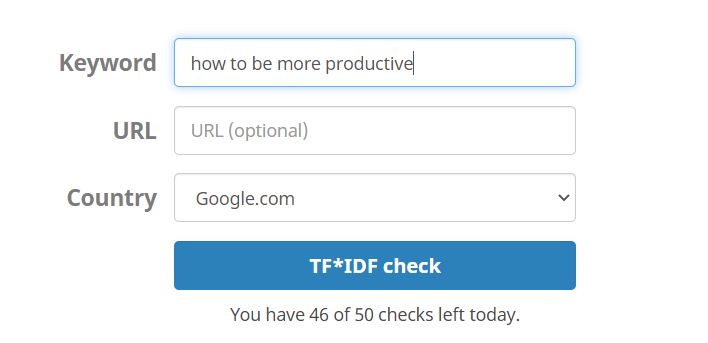
Click “TF-IDF Check,” and Seobility serves up a report with all the most common terms in Google’s top search results.

Just choose the most relevant keywords to add throughout your page.
Find Related Long Tail Keywords
Long tail keywords are low hanging fruit.
In fact, long tail keywords account for 70% of online search traffic — and since they often reflect a transactional search intent, they tend to convert better than shorter keywords.
To find relevant long tail keywords, use the keyword planning tools we mentioned above.
Start by searching for your primary keyword:
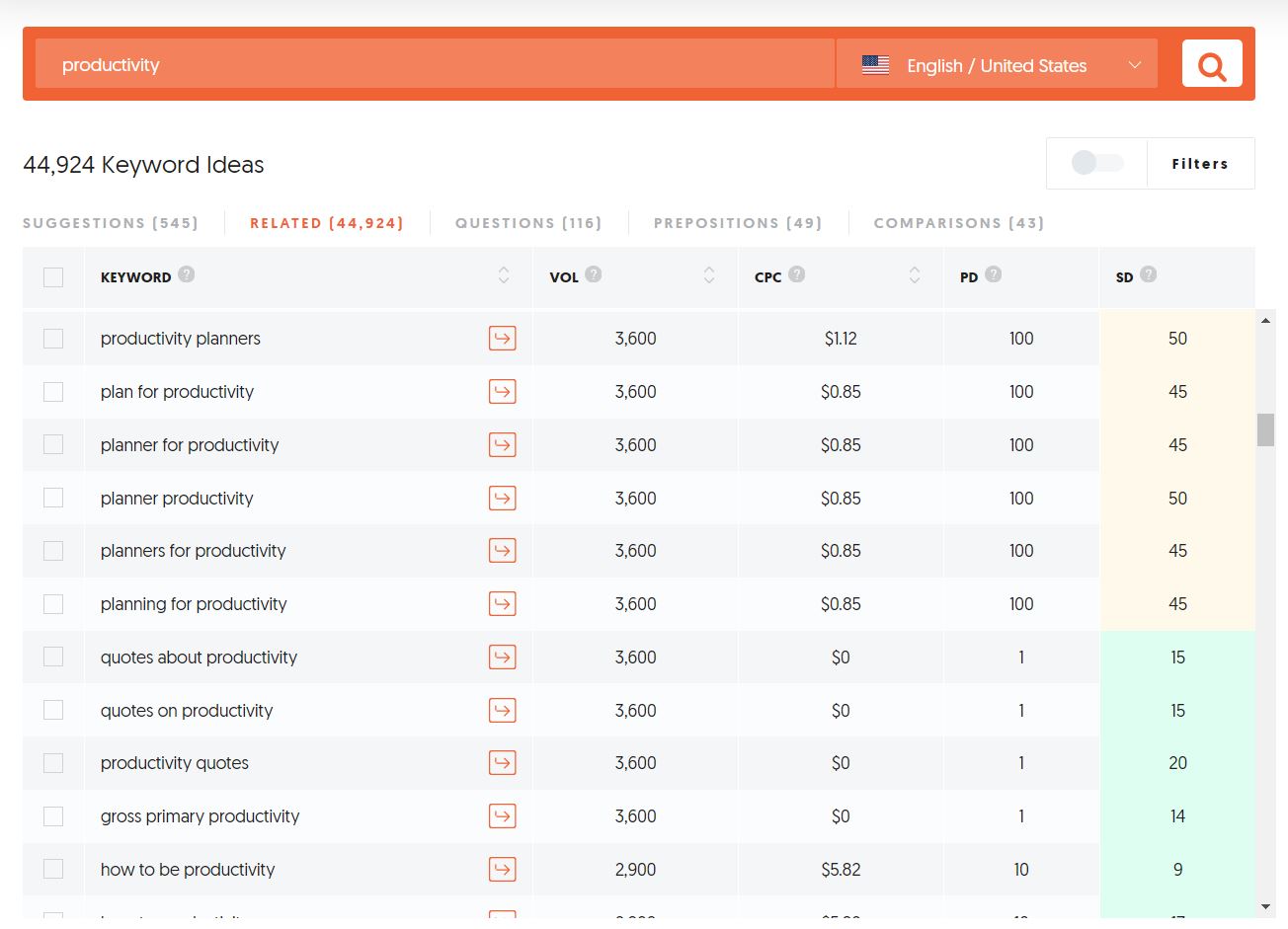
Sticking with the target keyword of “productivity,” Ubersuggest serves up lots of high-volume, low-difficulty long tail keywords in the search results:
- quotes about productivity
- best productivity app
- what does productivity mean
- best productivity planner
- productivity tools
These are all great keywords to sprinkle throughout your content.
Once you’ve found your secondary keywords, add them strategically throughout your content in your meta description, body copy, and subheadings.
Remember, keyword stuffing will sink you in Google’s rankings. Just add the keywords naturally wherever it feels appropriate.
16. Grab The Top Spot with Featured Snippets
You can write amazing copy.
You can optimize for SEO all day long.
But there’s one strategy that will leapfrog you ahead of the competition faster than any other:
Featured snippets.
Answering the questions your readers are asking quickly and concisely can give you a competitive edge and help you land the top spot in Google search results.
Here’s how to nail it.
- Provide simple, one-paragraph answers. Many questions can be answered in a couple of sentences or a short paragraph. Check out how Seobility grabbed the top spot with this quick, simple definition of “html sitemap”:

- Distill your answer down to a list. Especially with how-to questions, giving your answer as a list or a series of steps is a great way to grab the top spot. Here’s ActiveCampaign picking up the featured snippet for “how to be productive”:
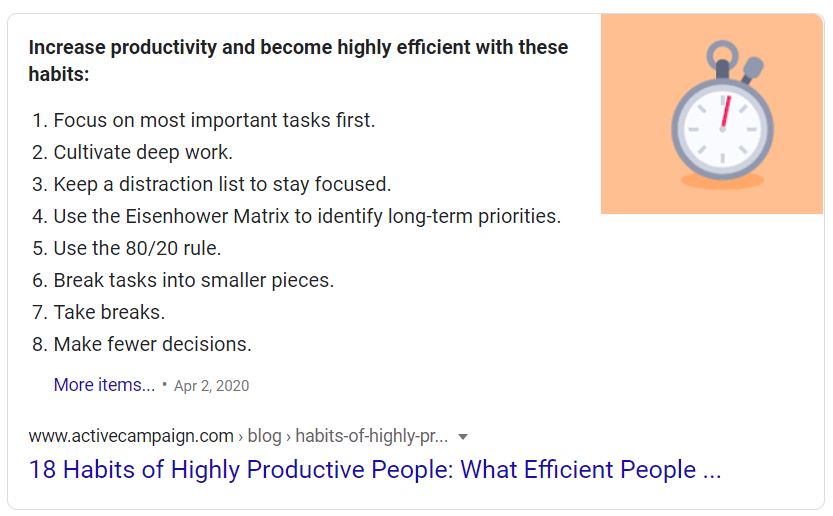
Giving a simple, clear answer to the questions you know readers are asking is a great way to grab the top spot.
Our Rank Tracking Dashboard in Seobility helps you keep an eye on your Featured Snippet placements. Sign up for free now and start tracking your website’s rankings.
![]()
Let’s keep moving.
17. Write Compelling Title Tags
Your title tag is the title that visitors see in search results.
Title tags are similar to headlines — but optimized to stand out in search and prompt readers to act.
Effective title tags:
- attract user attention
- include your primary keyword
- set an expectation
- and get users to click.
Naturally, that last bullet point is the most important. If users don’t click, your title tag did not do its job.
Here’s how to create an engaging, clickable title tag.
- Use emotional trigger words: Trigger words elicit a strong emotional response right off the bat. They’re a great way to create curiosity and make clicking your link almost irresistible. Use lists of power words from Sumo and CoSchedule to find lots of great trigger words you can add to your title tags.
- Include the year in your title: Let’s face it. The landscape in Fall 2020 looks drastically different than it did even a few months ago. Now more than ever, users want fresh, up to date results. And including the year in your title is a great way to communicate freshness and show that your results are up to date.
Here’s Wirecutter showing searchers that its standing desk reviews are up to date:

And the Kitchn also knows how it’s done, showing readers right away that their food processor reviews are current for 2020:

- Add modifiers: Using brackets or parentheses is a great way to provide additional information about what readers can expect.
The team at Sumo does a brilliant job of using this technique to give users a preview:
Words like free, guide, checklist, easy, fast, and simple are great words to include to give readers a quick preview of what’s included in your content.
18. Craft a Magnetic Meta Description
At this point your work is only half done.
After all, right after users read the title tag, they move on to the meta description.
And that means your meta description needs to be as irresistible as your title tag.
Skipping over the meta description hurts you in two ways.
If you don’t take the time to write a proper meta description, you’re signaling to Google that your site isn’t properly formatted. In effect, you’re telling Google you don’t deserve a high spot in their rankings.
Even worse, you’re leaving it up to chance what Google will pull into the meta description… and you know that’s going to hurt your performance in search.
Instead, take the time to write a persuasive meta description. This is a great place to sprinkle in your secondary keywords.
Home Chef nails it:

And Lofty Coffee knows what’s up:

On the other hand, Vigilante Coffee’s meta description needs a bit of love:

Your meta description is the first piece of copy many readers will see.
Take the time to write a description that gets them to say yes.
Looking to kick your meta descriptions up a notch? Check out our definitive guide to writing meta descriptions in 2020.
19. Use CTAs To Boost Shares And Traffic
Remember, copywriting is all about getting users to take action.
And the best way to get users to take action is super straightforward.
Ask for it.
Integrating calls to action into your text is one of the best ways to maximize shares and traffic. Click To Tweet is a simple, easy way to invite readers to share your content.
Start by heading over to clicktotweet.com.
Next, skim through your article.
Find actionable tips that could make great content for a tweet.
Then type out your tweet:

… and click Generate New Link.
Just copy and paste into your post.
It’s a great way to get more readers sharing your content.
Bonus Tip: Don’t Let Site Speed Slow You Down
So your copy looks amazing.
It’s SEO optimized five ways from Friday.
But:
You’re still getting no traffic.
Huh?
If you’ve got a slow loading site, It could be sending your bounce rate through the roof — and killing your conversions.
Site speed has been a major ranking factor for nearly a decade now. These days, 47% of users expect a web page to load in two seconds or less. And 40% will abandon a page if it takes more than three seconds to load.
The lesson is pretty clear: if your site is loading slow, fix it.
Do a quick website speed check right now. Head over to Pingdom’s website speed test.

Type in your website URL…
…and click “Start Test” to do a quick speed check.
If your site’s taking longer than two seconds to load, check out these tips to optimize your site to load fast.
Write Copy That Crushes It In Search
We’ve come a long way in this article.
Now you’ve got all the tools you need to craft magnetic copy and content that also crushes it in search.
But here’s the thing: advice like this is worthless if it sits in your bookmark folder.
Commit to taking the time to implement these tips right away. Start on your highest traffic page, where they’ll have the most impact. Later, you can work on your second most popular page. Then your third. And so on.
Give it a try. The more you put these tips into practice, the more traffic and conversions you’ll see!


